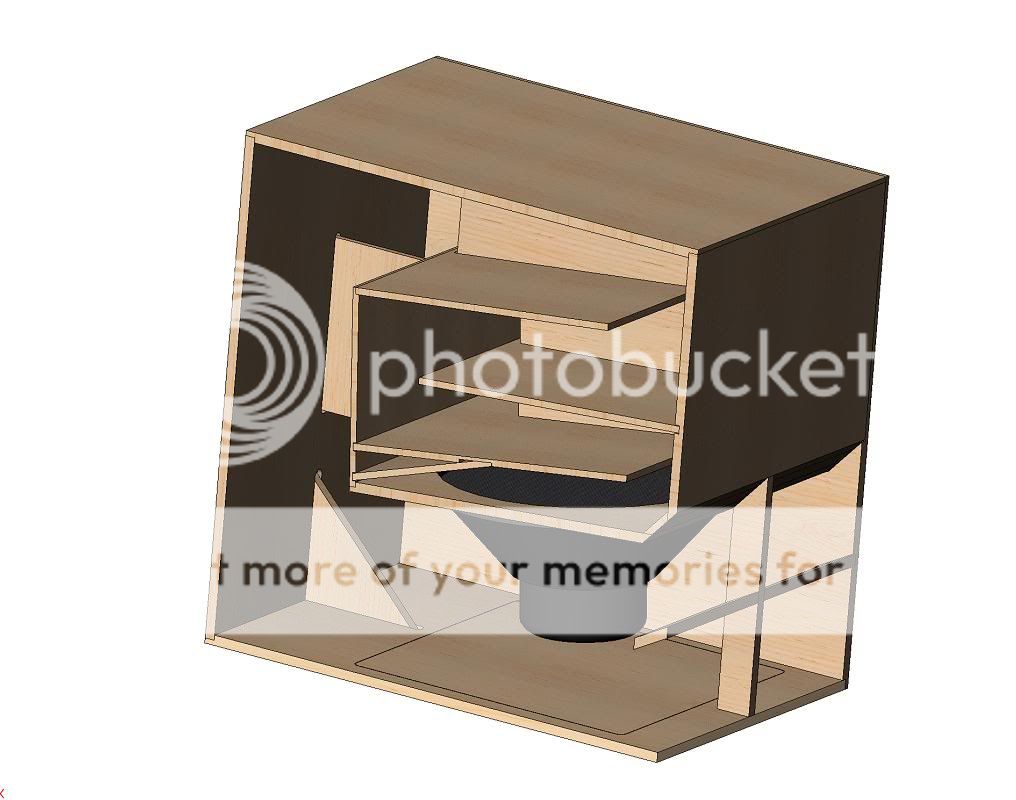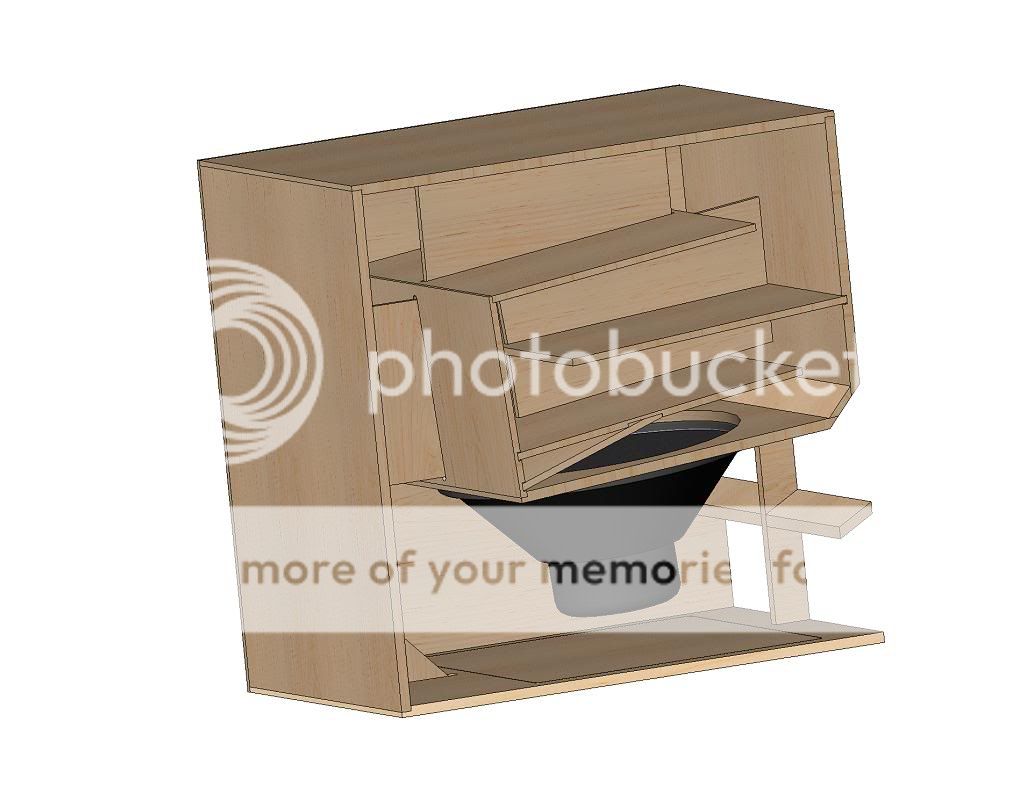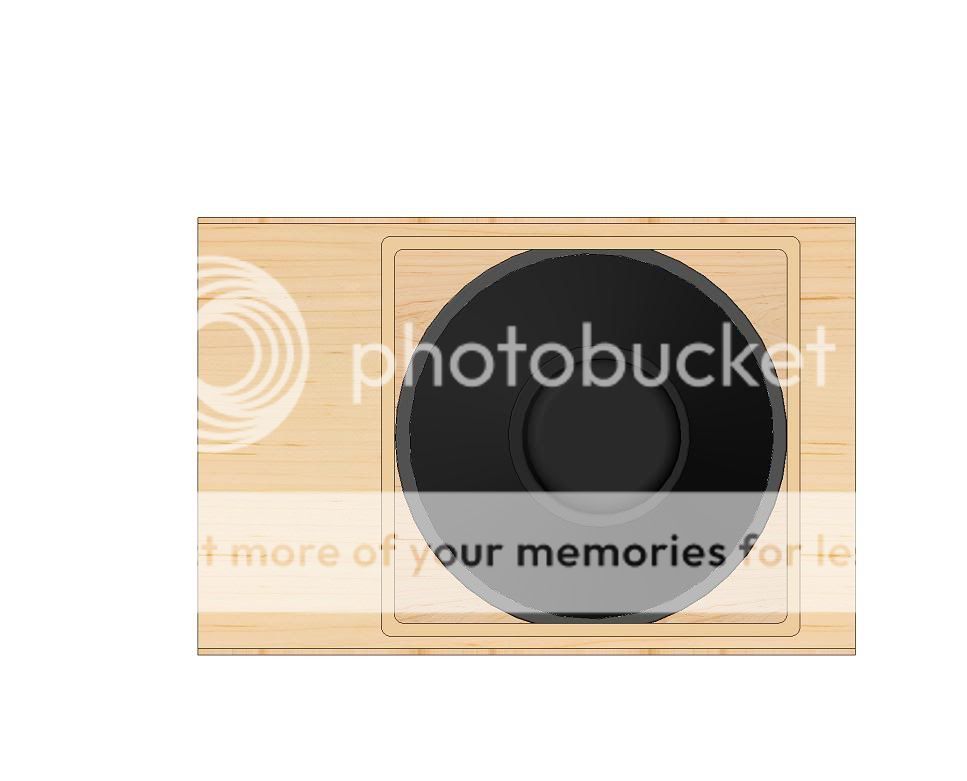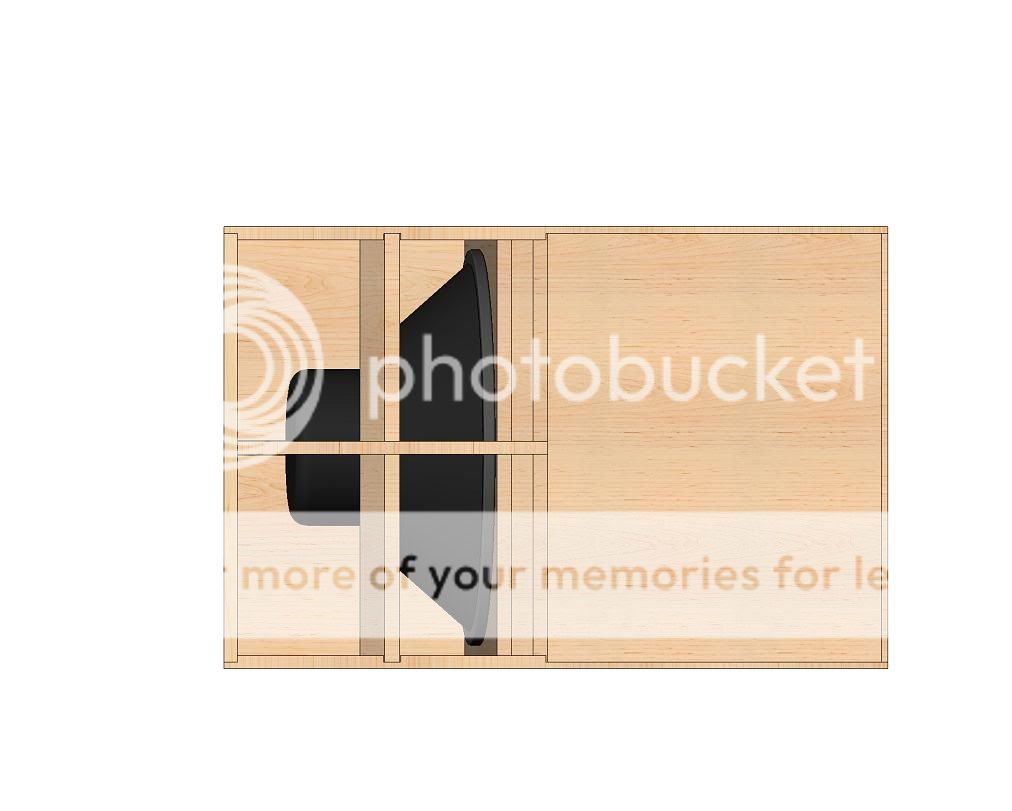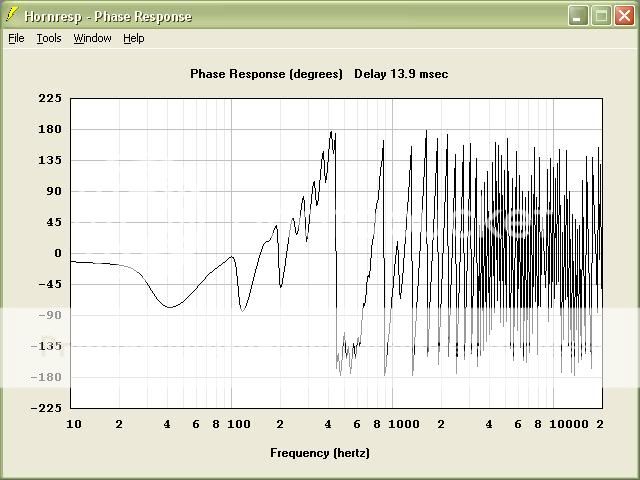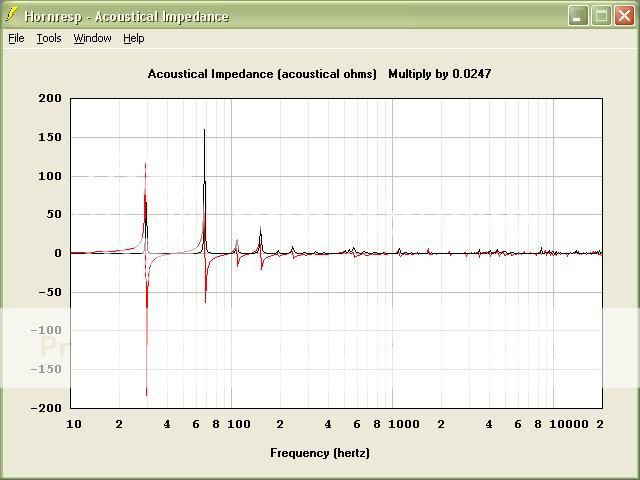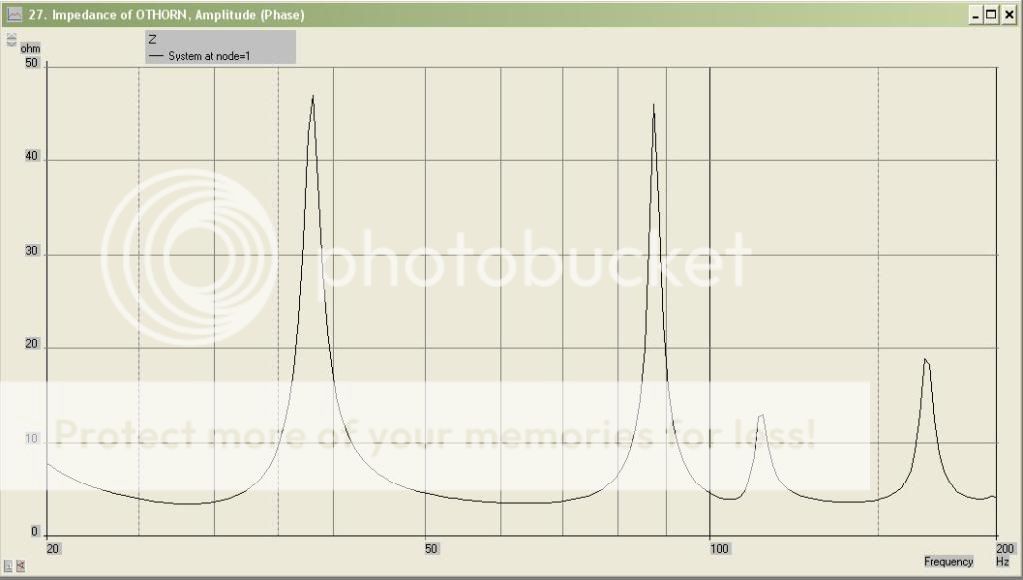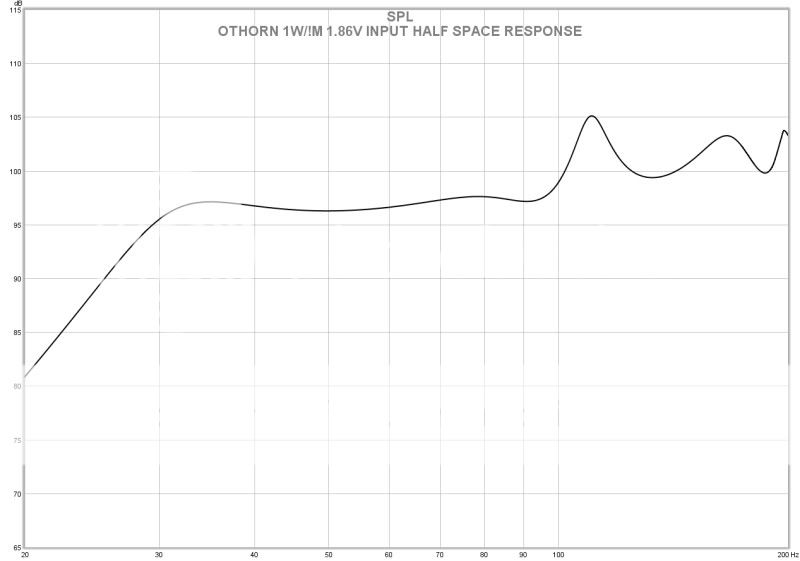Here is a tapped horn design intended for pro sound reinforcement type applications, or any just plain old, really loud music apps that I started working on last July and finally finished the design back at the beginning of March. I worked on this in tandem with the Gjallerhorn. I decided to have the Gjallerhorn built first as it was a larger, more complicated, more expensive and risky design. Since it turned out so well I am feeling rather confident about this one.  My goals with this design were true 30hz extension with solid useable output to the 25hz range. This is quite a bit lower than the majority of pro bass bins will really reach to despite their ratings. The increasing popularity of down tuned 5 and 6 string bass guitars, bass drops and the prevalance of DnB and Dubstep genres have started to ask for more power than ever from subs in the 25-35hz range. Along with this extension I wanted it to still be able to get quite loud and to retain decent sensitivity. I also decided to use an enclosure form of no larger than 36x36x24" which is large but not out of the ordinary for pro bass bins and comparable in total volume with many double 18" vented subs. A larger 45x45 type of cabinet like the Gjallerhorn or Labsub would've given better efficiency and higher output but these types of cabs are larger and heavier than I want to lug around very often. A pair of these should do most bars or small venues with no problem and 4 should do a good job in a mid sized venue. 2 will fit in the cargo hold of most medium sized suv's.
My goals with this design were true 30hz extension with solid useable output to the 25hz range. This is quite a bit lower than the majority of pro bass bins will really reach to despite their ratings. The increasing popularity of down tuned 5 and 6 string bass guitars, bass drops and the prevalance of DnB and Dubstep genres have started to ask for more power than ever from subs in the 25-35hz range. Along with this extension I wanted it to still be able to get quite loud and to retain decent sensitivity. I also decided to use an enclosure form of no larger than 36x36x24" which is large but not out of the ordinary for pro bass bins and comparable in total volume with many double 18" vented subs. A larger 45x45 type of cabinet like the Gjallerhorn or Labsub would've given better efficiency and higher output but these types of cabs are larger and heavier than I want to lug around very often. A pair of these should do most bars or small venues with no problem and 4 should do a good job in a mid sized venue. 2 will fit in the cargo hold of most medium sized suv's.
I already own a pair of B&C 21sw152-4 drivers and Danley has already used them in a couple of tapped horns so it was a no brainer to design around them.
Fast forwarding through about 9 months of design work and revisions here is what the final design will be. I will contract he same cabinet shop that built the Gjallerhorn cabs to do these as well. Unfortunately with everything else going on I don't have the time to build cabs this complicated myself anymore . Besides I could never deliver the build quality that the professionals can.
. Besides I could never deliver the build quality that the professionals can.
BTW Thanks to Soho54 for being my sanity checker on this cab design.
Here is the HornResponse and Akabak input data for simulating the cab. This one was also designed in Akabak working backwards from the cabinet size and best fold that would fit in the cab and achieve the right low corner instead of the other way around. I have found this works much easier for me than coming up with a pretty simulation and trying to fold and cram it into a workable cabinet while maintaining the parameters. Once again I use Akabak since there were so many folds, different expansion rates and corners involved. Amazingly the much simpler HR simulation that approximates the final Akabak one is very close. The differences are there but quite small. Not worth worrying about for most people unless you are a stickler like me who is worried about accuracy to the nth degree. Anyway here are the inputs.
NOTE: If you wish to model 18" drivers in this cabinet you should change the value of VTC to 4000 and the ATC value to 1465
HR
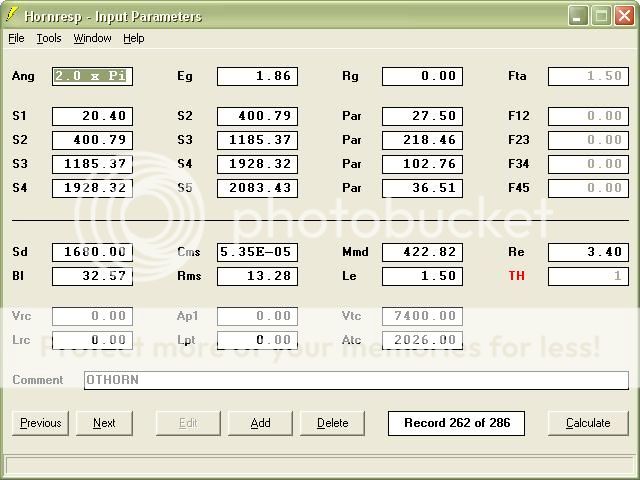
Akabak script
|COMMENT: OTHORN B&C 21SW152-4 30hz TH 36"x36"x24" revised 030411 completion(Driver restricts horn by approximately 517cm2 at S32)
|========================================================================================================
|REQUIRED AKABAK SETTINGS:
|File > Preferences > Physical system constants:
|Sound velocity c = 344m/s
|Medium density rho = 1.205kg/m3
|Sum > Acoustic power:
|Frequency range = 10Hz to 20kHz
|Points = 533
|Input voltage = 1.86V rms
|Integration = 2Pi-sr
|Integration steps = 1 degree ... 1 degree
|Integration method = Cross
|========================================================================================================
Def_Const |
{
|Length, area and volume values converted to metres, square metres and cubic metres:
S1 = 20.397216e-4; |Horn segment 1 throat area (sq cm)
S2 = 400.79072e-4; |Horn segment 1 mouth area and horn segment 2 throat area (sq cm)
S3 = 480.93721e-4; |Horn segment 2 mouth area and horn segment 3 throat area (sq cm)
S4 = 490.40735e-4; |Horn segment 3 mouth area and horn segment 4 throat area (sq cm)
S5 = 499.87748e-4; |Horn segment 4 mouth area and horn segment 5 throat area (sq cm)
S6 = 503.41786e-4; |Horn segment 5 mouth area and horn segment 6 throat area (sq cm)
S7 = 752.67183e-4; |Horn segment 6 mouth area and horn segment 7 throat area (sq cm)
S8 = 525.374e-4; |Horn segment 7 mouth area and horn segment 8 throat area (sq cm)
S9 = 672.07369e-4; |Horn segment 8 mouth area and horn segment 9 throat area (sq cm)
S10 = 1003.4701e-4; |Horn segment 9 mouth area and horn segment 10 throat area (sq cm)
S11 = 706.47214e-4; |Horn segment 10 mouth area and horn segment 11 throat area (sq cm)
S12 = 710.68271e-4; |Horn segment 11 mouth area and horn segment 12 throat area (sq cm)
S13 = 1011.4833e-4; |Horn segment 12 mouth area and horn segment 13 throat area (sq cm)
S14 = 744.03216e-4; |Horn segment 13 mouth area and horn segment 14 throat area (sq cm)
S15 = 827.70445e-4; |Horn segment 14 mouth area and horn segment 15 throat area (sq cm)
S16 = 1148.9606e-4; |Horn segment 15 mouth area and horn segment 16 throat area (sq cm)
S17 = 850.19967e-4; |Horn segment 16 mouth area and horn segment 17 throat area (sq cm)
S18 = 852.58905e-4; |Horn segment 17 mouth area and horn segment 18 throat area (sq cm)
S19 = 1222.0554e-4; |Horn segment 18 mouth area and horn segment 19 throat area (sq cm)
S20 = 876.8326e-4; |Horn segment 19 mouth area and horn segment 20 throat area (sq cm)
S21 = 434.06586e-4; |Horn segment 20 mouth area and horn segment 21a throat area (sq cm)
S22 = 572.31875e-4; |Horn segment 21a mouth area and horn segment 22a throat area (sq cm)|
S23 = 1185.3696e-4; |Horn segment 22a mouth area and horn segment 23 throat area (sq cm)
S24 = 1724.8322e-4; |Horn segment 23 mouth area and horn segment 24 throat area (sq cm)
S25 = 1255.2883e-4; |Horn segment 24 mouth area and horn segment 25 throat area (sq cm)
S26 = 619.44195e-4; |Horn segment 25 mouth area and horn segment 26a throat area (sq cm)|
S27 = 680.54455e-4; |Horn segment 26a mouth area and horn segment 27a throat area (sq cm)|
S28 = 1400.7642e-4; |Horn segment 27a mouth area and horn segment 28 throat area (sq cm)
S29 = 2279.1994e-4; |Horn segment 28 mouth area and horn segment 29 throat area (sq cm)
S30 = 1799.9231e-4; |Horn segment 29 mouth area and horn segment 30 throat area (sq cm)
S31 = 1805.1536e-4; |Horn segment 30 mouth area and horn segment 31 throat area (sq cm)
S32 = 1411.3236e-4; |Horn segment 31 mouth area and horn segment 32 throat area (sq cm)/(1411.3236cm restricted by driver (estimated),1928.3236cm ignoring driver in path)
S33 = 2043.1017e-4; |Horn segment 32 mouth area and horn segment 33 throat area (sq cm)
S34 = 2057.0009e-4; |Horn segment 33 mouth area and horn segment 34 throat area (sq cm)
S35 = 2260.638e-4; |Horn segment 34 mouth area (sq cm)
L12 = 27.504644e-2; |Horn segment 1 axial length (cm)
L23 = 27.258518e-2; |Horn segment 2 axial length (cm)
L34 = 3.070098e-2; |Horn segment 3 axial length (cm)
L45 = 3.355594e-2; |Horn segment 4 axial length (cm)
L56 = 1.203198e-2; |Horn segment 5 axial length (cm)
L67 = 3.625088e-2; |Horn segment 6 axial length (cm)
L78 = 3.781298e-2; |Horn segment 7 axial length (cm)
L89 = 41.853612e-2; |Horn segment 8 axial length (cm)
L910 = 4.81838e-2; |Horn segment 9 axial length (cm)
L1011 = 5.029708e-2; |Horn segment 10 axial length (cm)
L1112 = 1.20142e-2; |Horn segment 11 axial length (cm)
L1213 = 4.740656e-2; |Horn segment 12 axial length (cm)
L1314 = 4.877562e-2; |Horn segment 13 axial length (cm)
L1415 = 37.930582e-2; |Horn segment 14 axial length (cm)
L1516 = 5.453888e-2; |Horn segment 15 axial length (cm)
L1617 = 5.582412e-2; |Horn segment 16 axial length (cm)
L1718 = 1.20269e-2; |Horn segment 17 axial length (cm)
L1819 = 5.869432e-2; |Horn segment 18 axial length (cm)
L1920 = 6.282436e-2; |Horn segment 19 axial length (cm)
L2021 = 1.371346e-2; |Horn segment 20 axial length (cm)
L2122 = 46.972982e-2; |Horn segment 21a axial length (cm)
L2223 = 2.97434e-2; |Horn segment 22 axial length (cm)
L2324 = 7.91972e-2; |Horn segment 23 axial length (cm)
L2425 = 8.488172e-2; |Horn segment 24 axial length (cm)
L2526 = 2.246376e-2; |Horn segment 25 axial length (cm)
L2627 = 30.794452e-2; |Horn segment 26a axial length (cm)
L2728 = 2.872232e-2; |Horn segment 27 axial length (cm)
L2829 = 11.00836e-2; |Horn segment 28 axial length (cm)
L2930 = 10.296144e-2; |Horn segment 29 axial length (cm)
L3031 = 1.199134e-2; |Horn segment 30 axial length (cm)
L3132 = 27.93238e-2; |Horn segment 31 axial length (cm)
L3233 = 26.647902e-2; |Horn segment 32 axial length (cm)
L3334 = 3.189478e-2; |Horn segment 33 axial length (cm)
L3435 = 6.672834e-2; |Horn segment 34 axial length (cm)
Vtc = 7400e-6; |Throat chamber volume (cc)(Estimated)
Atc = 2026.00e-4; |Throat chamber cross-sectional area (sq cm) (Estimated)
|Parameter Conversions:
Sd = 1680.00e-4; |Diaphragm area (sq cm)
Ltc = Vtc / Atc;
}
|========================================================================================================
|Network node numbers for this tapped horn system:
| 0-Voltage-1
| |
| -Chamber-5-Driver---
| | |
|8-Segment-9-Segment-10-Segment-11-Segment-12-Segment-13-Segment-14-Segment-15-Segment-16-Segment-17-Segment-18-Segment-19-Segment-20-Segment-21-Segment-22-Segment-23-Segment-24-Segment-25-Segment-26-Segment-27-Segment-28-Segment-29-Segment-30-Segment-31-Segment-32-Segment-33-Segment-34-Segment-35-Segment-36-Segment-37-Segment-38-Segment-39-Segment-40-Segment-41-Segment-42-Radiator
|========================================================================================================
Def_Driver 'Driver'
Sd=1680.00cm2
Bl=32.57Tm
Cms=5.35E-05m/N
Rms=13.28Ns/m
fs=32.0001Hz |Mmd = 422.82g not recognised by AkAbak, fs calculated and used instead
Le=1.50mH
Re=3.40ohm
ExpoLe=1
System 'System'
Driver Def='Driver''Driver'
Node=1=0=5=39
Duct 'Throat chamber'
Node=5=9
SD={Atc}
Len={Ltc}
Visc=0
Waveguide 'Segment 1'
Node=8=9
STh={S1}
SMo={S2}
Len={L12}
Waveguide 'Segment 2'
Node=9=10
STh={S2}
SMo={S3}
Len={L23}
Waveguide 'Segment 3'
Node=10=11
STh={S3}
SMo={S4}
Len={L34}
Waveguide 'Segment 4'
Node=11=12
STh={S4}
SMo={S5}
Len={L45}
Waveguide 'Segment 5'
Node=12=13
STh={S5}
SMo={S6}
Len={L56}
Waveguide 'Segment 6'
Node=13=14
STh={S6}
SMo={S7}
Len={L67}
Waveguide 'Segment 7'
Node=15=14
STh={S8}
SMo={S7}
Len={L78}
Waveguide 'Segment 8'
Node=15=16
STh={S8}
SMo={S9}
Len={L89}
Waveguide 'Segment 9'
Node=16=17
STh={S9}
SMo={S10}
Len={L910}
Waveguide 'Segment 10'
Node=18=17
STh={S11}
SMo={S10}
Len={L1011}
Waveguide 'Segment 11'
Node=18=19
STh={S11}
SMo={S12}
Len={L1112}
Waveguide 'Segment 12'
Node=19=20
STh={S12}
SMo={S13}
Len={L1213}
Waveguide 'Segment 13'
Node=21=20
STh={S14}
SMo={S13}
Len={L1314}
Waveguide 'Segment 14'
Node=21=22
STh={S14}
SMo={S15}
Len={L1415}
Waveguide 'Segment 15'
Node=22=23
STh={S15}
SMo={S16}
Len={L1516}
Waveguide 'Segment 16'
Node=24=23
STh={S17}
SMo={S16}
Len={L1617}
Waveguide 'Segment 17'
Node=24=25
STh={S17}
SMo={S18}
Len={L1718}
Waveguide 'Segment 18'
Node=25=26
STh={S18}
SMo={S19}
Len={L1819}
Waveguide 'Segment 19'
Node=27=26
STh={S20}
SMo={S19}
Len={L1920}
Waveguide 'Segment 20'
Node=28=27
STh={S21}
SMo={S20}
Len={L2021}
Waveguide 'Segment 21'
Node=28=29
STh={S21}
SMo={S22}
Len={L2122}
Waveguide 'Segment 21b'
Node=28=29
STh={S21}
SMo={S22}
Len={L2122}
Waveguide 'Segment 22'
Node=29=30
STh={S22}
SMo={S23}
Len={L2223}
Waveguide 'Segment 23'
Node=30=31
STh={S23}
SMo={S24}
Len={L2324}
Waveguide 'Segment 24'
Node=32=31
STh={S25}
SMo={S24}
Len={L2425}
Waveguide 'Segment 25'
Node=33=32
STh={S26}
SMo={S25}
Len={L2526}
Waveguide 'Segment 26'
Node=33=34
STh={S26}
SMo={S27}
Len={L2627}
Waveguide 'Segment 26b'
Node=33=34
STh={S26}
SMo={S27}
Len={L2627}
Waveguide 'Segment 27'
Node=34=35
STh={S27}
SMo={S28}
Len={L2728}
Waveguide 'Segment 28'
Node=36=35
STh={S28}
SMo={S29}
Len={L2829}
Waveguide 'Segment 29'
Node=36=37
STh={S30}
SMo={S29}
Len={L2930}
Waveguide 'Segment 30'
Node=37=38
STh={S30}
SMo={S31}
Len={L3031}
Waveguide 'Segment 31'
Node=39=38
STh={S32}
SMo={S31}
Len={L3132}
Waveguide 'Segment 32'
Node=39=40
STh={S32}
SMo={S33}
Len={L3233}
Waveguide 'Segment 33'
Node=40=41
STh={S33}
SMo={S34}
Len={L3334}
Waveguide 'Segment 34'
Node=41=42
STh={S34}
SMo={S35}
Len={L3435}
Radiator 'Horn mouth'
Node=42
SD={S35}
I already own a pair of B&C 21sw152-4 drivers and Danley has already used them in a couple of tapped horns so it was a no brainer to design around them.
Fast forwarding through about 9 months of design work and revisions here is what the final design will be. I will contract he same cabinet shop that built the Gjallerhorn cabs to do these as well. Unfortunately with everything else going on I don't have the time to build cabs this complicated myself anymore
BTW Thanks to Soho54 for being my sanity checker on this cab design.
Here is the HornResponse and Akabak input data for simulating the cab. This one was also designed in Akabak working backwards from the cabinet size and best fold that would fit in the cab and achieve the right low corner instead of the other way around. I have found this works much easier for me than coming up with a pretty simulation and trying to fold and cram it into a workable cabinet while maintaining the parameters. Once again I use Akabak since there were so many folds, different expansion rates and corners involved. Amazingly the much simpler HR simulation that approximates the final Akabak one is very close. The differences are there but quite small. Not worth worrying about for most people unless you are a stickler like me who is worried about accuracy to the nth degree. Anyway here are the inputs.
NOTE: If you wish to model 18" drivers in this cabinet you should change the value of VTC to 4000 and the ATC value to 1465
HR

Akabak script
|COMMENT: OTHORN B&C 21SW152-4 30hz TH 36"x36"x24" revised 030411 completion(Driver restricts horn by approximately 517cm2 at S32)
|========================================================================================================
|REQUIRED AKABAK SETTINGS:
|File > Preferences > Physical system constants:
|Sound velocity c = 344m/s
|Medium density rho = 1.205kg/m3
|Sum > Acoustic power:
|Frequency range = 10Hz to 20kHz
|Points = 533
|Input voltage = 1.86V rms
|Integration = 2Pi-sr
|Integration steps = 1 degree ... 1 degree
|Integration method = Cross
|========================================================================================================
Def_Const |
{
|Length, area and volume values converted to metres, square metres and cubic metres:
S1 = 20.397216e-4; |Horn segment 1 throat area (sq cm)
S2 = 400.79072e-4; |Horn segment 1 mouth area and horn segment 2 throat area (sq cm)
S3 = 480.93721e-4; |Horn segment 2 mouth area and horn segment 3 throat area (sq cm)
S4 = 490.40735e-4; |Horn segment 3 mouth area and horn segment 4 throat area (sq cm)
S5 = 499.87748e-4; |Horn segment 4 mouth area and horn segment 5 throat area (sq cm)
S6 = 503.41786e-4; |Horn segment 5 mouth area and horn segment 6 throat area (sq cm)
S7 = 752.67183e-4; |Horn segment 6 mouth area and horn segment 7 throat area (sq cm)
S8 = 525.374e-4; |Horn segment 7 mouth area and horn segment 8 throat area (sq cm)
S9 = 672.07369e-4; |Horn segment 8 mouth area and horn segment 9 throat area (sq cm)
S10 = 1003.4701e-4; |Horn segment 9 mouth area and horn segment 10 throat area (sq cm)
S11 = 706.47214e-4; |Horn segment 10 mouth area and horn segment 11 throat area (sq cm)
S12 = 710.68271e-4; |Horn segment 11 mouth area and horn segment 12 throat area (sq cm)
S13 = 1011.4833e-4; |Horn segment 12 mouth area and horn segment 13 throat area (sq cm)
S14 = 744.03216e-4; |Horn segment 13 mouth area and horn segment 14 throat area (sq cm)
S15 = 827.70445e-4; |Horn segment 14 mouth area and horn segment 15 throat area (sq cm)
S16 = 1148.9606e-4; |Horn segment 15 mouth area and horn segment 16 throat area (sq cm)
S17 = 850.19967e-4; |Horn segment 16 mouth area and horn segment 17 throat area (sq cm)
S18 = 852.58905e-4; |Horn segment 17 mouth area and horn segment 18 throat area (sq cm)
S19 = 1222.0554e-4; |Horn segment 18 mouth area and horn segment 19 throat area (sq cm)
S20 = 876.8326e-4; |Horn segment 19 mouth area and horn segment 20 throat area (sq cm)
S21 = 434.06586e-4; |Horn segment 20 mouth area and horn segment 21a throat area (sq cm)
S22 = 572.31875e-4; |Horn segment 21a mouth area and horn segment 22a throat area (sq cm)|
S23 = 1185.3696e-4; |Horn segment 22a mouth area and horn segment 23 throat area (sq cm)
S24 = 1724.8322e-4; |Horn segment 23 mouth area and horn segment 24 throat area (sq cm)
S25 = 1255.2883e-4; |Horn segment 24 mouth area and horn segment 25 throat area (sq cm)
S26 = 619.44195e-4; |Horn segment 25 mouth area and horn segment 26a throat area (sq cm)|
S27 = 680.54455e-4; |Horn segment 26a mouth area and horn segment 27a throat area (sq cm)|
S28 = 1400.7642e-4; |Horn segment 27a mouth area and horn segment 28 throat area (sq cm)
S29 = 2279.1994e-4; |Horn segment 28 mouth area and horn segment 29 throat area (sq cm)
S30 = 1799.9231e-4; |Horn segment 29 mouth area and horn segment 30 throat area (sq cm)
S31 = 1805.1536e-4; |Horn segment 30 mouth area and horn segment 31 throat area (sq cm)
S32 = 1411.3236e-4; |Horn segment 31 mouth area and horn segment 32 throat area (sq cm)/(1411.3236cm restricted by driver (estimated),1928.3236cm ignoring driver in path)
S33 = 2043.1017e-4; |Horn segment 32 mouth area and horn segment 33 throat area (sq cm)
S34 = 2057.0009e-4; |Horn segment 33 mouth area and horn segment 34 throat area (sq cm)
S35 = 2260.638e-4; |Horn segment 34 mouth area (sq cm)
L12 = 27.504644e-2; |Horn segment 1 axial length (cm)
L23 = 27.258518e-2; |Horn segment 2 axial length (cm)
L34 = 3.070098e-2; |Horn segment 3 axial length (cm)
L45 = 3.355594e-2; |Horn segment 4 axial length (cm)
L56 = 1.203198e-2; |Horn segment 5 axial length (cm)
L67 = 3.625088e-2; |Horn segment 6 axial length (cm)
L78 = 3.781298e-2; |Horn segment 7 axial length (cm)
L89 = 41.853612e-2; |Horn segment 8 axial length (cm)
L910 = 4.81838e-2; |Horn segment 9 axial length (cm)
L1011 = 5.029708e-2; |Horn segment 10 axial length (cm)
L1112 = 1.20142e-2; |Horn segment 11 axial length (cm)
L1213 = 4.740656e-2; |Horn segment 12 axial length (cm)
L1314 = 4.877562e-2; |Horn segment 13 axial length (cm)
L1415 = 37.930582e-2; |Horn segment 14 axial length (cm)
L1516 = 5.453888e-2; |Horn segment 15 axial length (cm)
L1617 = 5.582412e-2; |Horn segment 16 axial length (cm)
L1718 = 1.20269e-2; |Horn segment 17 axial length (cm)
L1819 = 5.869432e-2; |Horn segment 18 axial length (cm)
L1920 = 6.282436e-2; |Horn segment 19 axial length (cm)
L2021 = 1.371346e-2; |Horn segment 20 axial length (cm)
L2122 = 46.972982e-2; |Horn segment 21a axial length (cm)
L2223 = 2.97434e-2; |Horn segment 22 axial length (cm)
L2324 = 7.91972e-2; |Horn segment 23 axial length (cm)
L2425 = 8.488172e-2; |Horn segment 24 axial length (cm)
L2526 = 2.246376e-2; |Horn segment 25 axial length (cm)
L2627 = 30.794452e-2; |Horn segment 26a axial length (cm)
L2728 = 2.872232e-2; |Horn segment 27 axial length (cm)
L2829 = 11.00836e-2; |Horn segment 28 axial length (cm)
L2930 = 10.296144e-2; |Horn segment 29 axial length (cm)
L3031 = 1.199134e-2; |Horn segment 30 axial length (cm)
L3132 = 27.93238e-2; |Horn segment 31 axial length (cm)
L3233 = 26.647902e-2; |Horn segment 32 axial length (cm)
L3334 = 3.189478e-2; |Horn segment 33 axial length (cm)
L3435 = 6.672834e-2; |Horn segment 34 axial length (cm)
Vtc = 7400e-6; |Throat chamber volume (cc)(Estimated)
Atc = 2026.00e-4; |Throat chamber cross-sectional area (sq cm) (Estimated)
|Parameter Conversions:
Sd = 1680.00e-4; |Diaphragm area (sq cm)
Ltc = Vtc / Atc;
}
|========================================================================================================
|Network node numbers for this tapped horn system:
| 0-Voltage-1
| |
| -Chamber-5-Driver---
| | |
|8-Segment-9-Segment-10-Segment-11-Segment-12-Segment-13-Segment-14-Segment-15-Segment-16-Segment-17-Segment-18-Segment-19-Segment-20-Segment-21-Segment-22-Segment-23-Segment-24-Segment-25-Segment-26-Segment-27-Segment-28-Segment-29-Segment-30-Segment-31-Segment-32-Segment-33-Segment-34-Segment-35-Segment-36-Segment-37-Segment-38-Segment-39-Segment-40-Segment-41-Segment-42-Radiator
|========================================================================================================
Def_Driver 'Driver'
Sd=1680.00cm2
Bl=32.57Tm
Cms=5.35E-05m/N
Rms=13.28Ns/m
fs=32.0001Hz |Mmd = 422.82g not recognised by AkAbak, fs calculated and used instead
Le=1.50mH
Re=3.40ohm
ExpoLe=1
System 'System'
Driver Def='Driver''Driver'
Node=1=0=5=39
Duct 'Throat chamber'
Node=5=9
SD={Atc}
Len={Ltc}
Visc=0
Waveguide 'Segment 1'
Node=8=9
STh={S1}
SMo={S2}
Len={L12}
Waveguide 'Segment 2'
Node=9=10
STh={S2}
SMo={S3}
Len={L23}
Waveguide 'Segment 3'
Node=10=11
STh={S3}
SMo={S4}
Len={L34}
Waveguide 'Segment 4'
Node=11=12
STh={S4}
SMo={S5}
Len={L45}
Waveguide 'Segment 5'
Node=12=13
STh={S5}
SMo={S6}
Len={L56}
Waveguide 'Segment 6'
Node=13=14
STh={S6}
SMo={S7}
Len={L67}
Waveguide 'Segment 7'
Node=15=14
STh={S8}
SMo={S7}
Len={L78}
Waveguide 'Segment 8'
Node=15=16
STh={S8}
SMo={S9}
Len={L89}
Waveguide 'Segment 9'
Node=16=17
STh={S9}
SMo={S10}
Len={L910}
Waveguide 'Segment 10'
Node=18=17
STh={S11}
SMo={S10}
Len={L1011}
Waveguide 'Segment 11'
Node=18=19
STh={S11}
SMo={S12}
Len={L1112}
Waveguide 'Segment 12'
Node=19=20
STh={S12}
SMo={S13}
Len={L1213}
Waveguide 'Segment 13'
Node=21=20
STh={S14}
SMo={S13}
Len={L1314}
Waveguide 'Segment 14'
Node=21=22
STh={S14}
SMo={S15}
Len={L1415}
Waveguide 'Segment 15'
Node=22=23
STh={S15}
SMo={S16}
Len={L1516}
Waveguide 'Segment 16'
Node=24=23
STh={S17}
SMo={S16}
Len={L1617}
Waveguide 'Segment 17'
Node=24=25
STh={S17}
SMo={S18}
Len={L1718}
Waveguide 'Segment 18'
Node=25=26
STh={S18}
SMo={S19}
Len={L1819}
Waveguide 'Segment 19'
Node=27=26
STh={S20}
SMo={S19}
Len={L1920}
Waveguide 'Segment 20'
Node=28=27
STh={S21}
SMo={S20}
Len={L2021}
Waveguide 'Segment 21'
Node=28=29
STh={S21}
SMo={S22}
Len={L2122}
Waveguide 'Segment 21b'
Node=28=29
STh={S21}
SMo={S22}
Len={L2122}
Waveguide 'Segment 22'
Node=29=30
STh={S22}
SMo={S23}
Len={L2223}
Waveguide 'Segment 23'
Node=30=31
STh={S23}
SMo={S24}
Len={L2324}
Waveguide 'Segment 24'
Node=32=31
STh={S25}
SMo={S24}
Len={L2425}
Waveguide 'Segment 25'
Node=33=32
STh={S26}
SMo={S25}
Len={L2526}
Waveguide 'Segment 26'
Node=33=34
STh={S26}
SMo={S27}
Len={L2627}
Waveguide 'Segment 26b'
Node=33=34
STh={S26}
SMo={S27}
Len={L2627}
Waveguide 'Segment 27'
Node=34=35
STh={S27}
SMo={S28}
Len={L2728}
Waveguide 'Segment 28'
Node=36=35
STh={S28}
SMo={S29}
Len={L2829}
Waveguide 'Segment 29'
Node=36=37
STh={S30}
SMo={S29}
Len={L2930}
Waveguide 'Segment 30'
Node=37=38
STh={S30}
SMo={S31}
Len={L3031}
Waveguide 'Segment 31'
Node=39=38
STh={S32}
SMo={S31}
Len={L3132}
Waveguide 'Segment 32'
Node=39=40
STh={S32}
SMo={S33}
Len={L3233}
Waveguide 'Segment 33'
Node=40=41
STh={S33}
SMo={S34}
Len={L3334}
Waveguide 'Segment 34'
Node=41=42
STh={S34}
SMo={S35}
Len={L3435}
Radiator 'Horn mouth'
Node=42
SD={S35}
Large Signal Simulation Data
This enclosure should be able to take brief 120v input peaks anywhere above 24hz without risk of damage. Roughly 4200w into the minimum impedances in the pass band. This lines up pretty well with what some of the larger touring amplifiers on the market are rated at into 4ohm stereo loads. At that power level the cone excursion reaches 20mm at the in band excursion peak and at 24.5hz. I know from using these drivers and testing them that this is about the point where they get non linear and start to make suspension noises. Additional input power does not produce much further excursion with these drivers as the motor force is drastically reduced and the suspension is uber tight. An input of about 95volts puts the cone excursion right at xmax between 15-16mm. Also a 25hz 24db octave Butterworth hpf will be used on these since cone excursion sky rockets below 25hz as the driver unloads.
All of the simulation data below is at 120v input.
Akabak power density
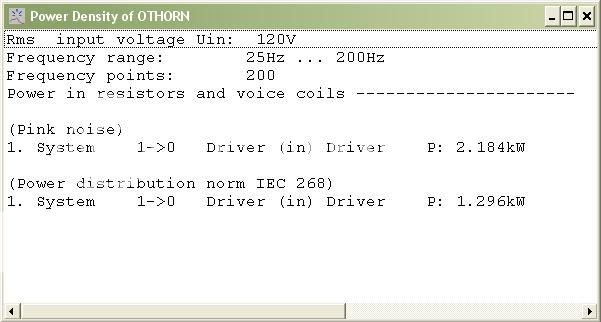
HR Excursion 120v
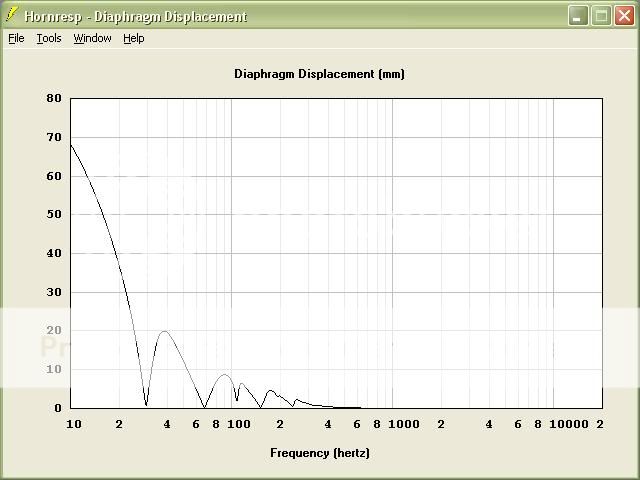
Akabak excursion 120v
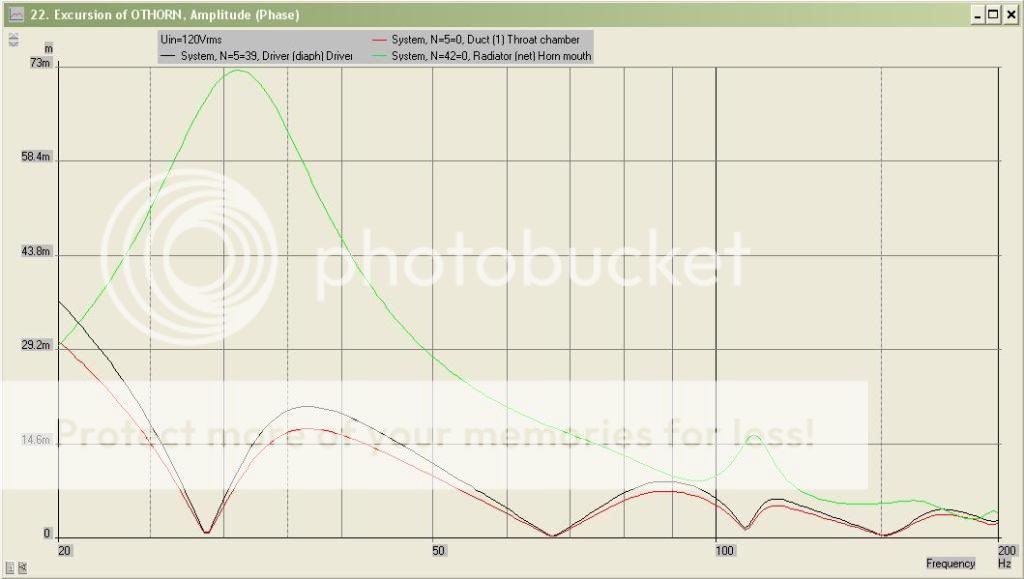
Power applied
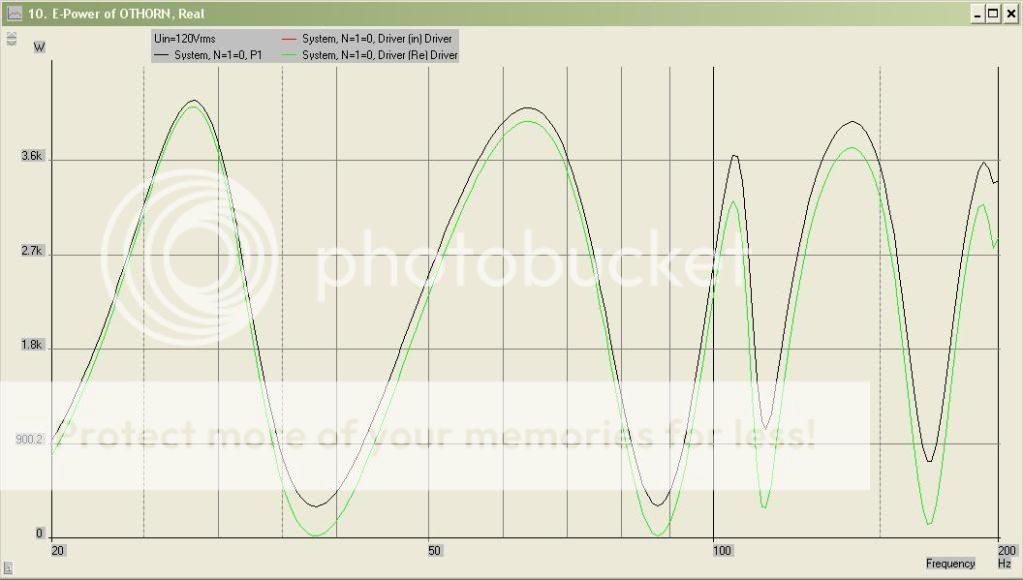
Current applied
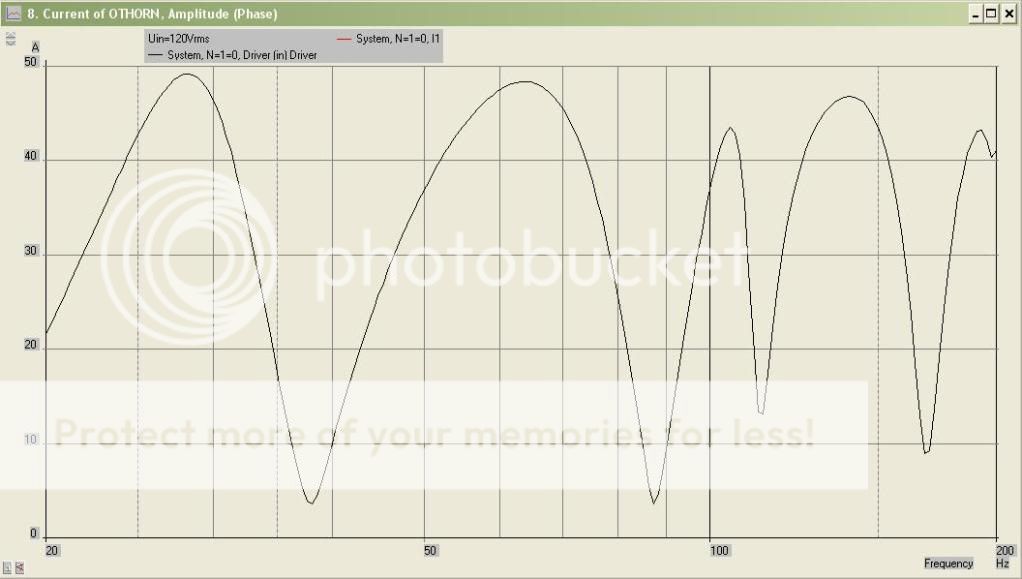
Velocity
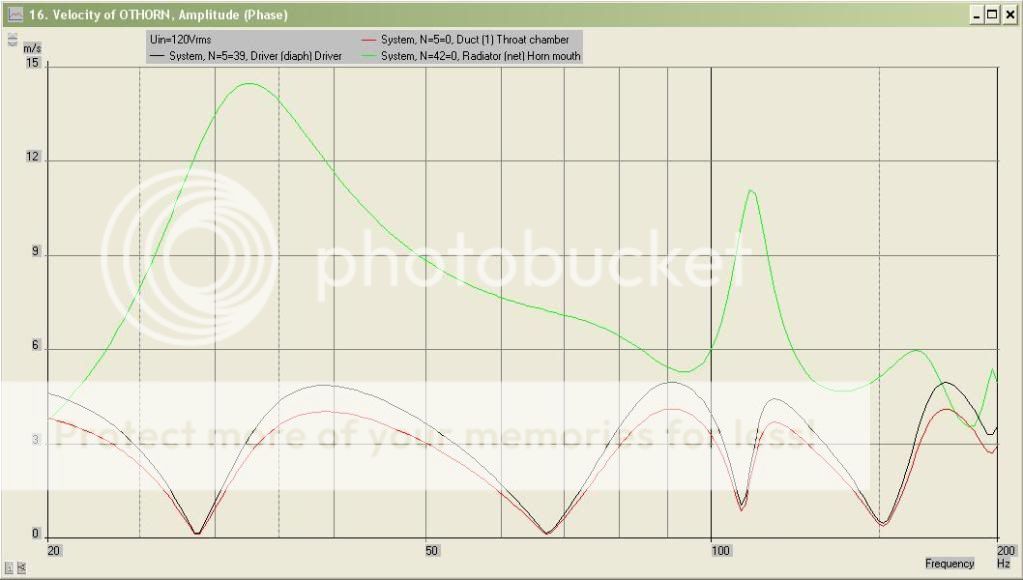
Volume Velocity
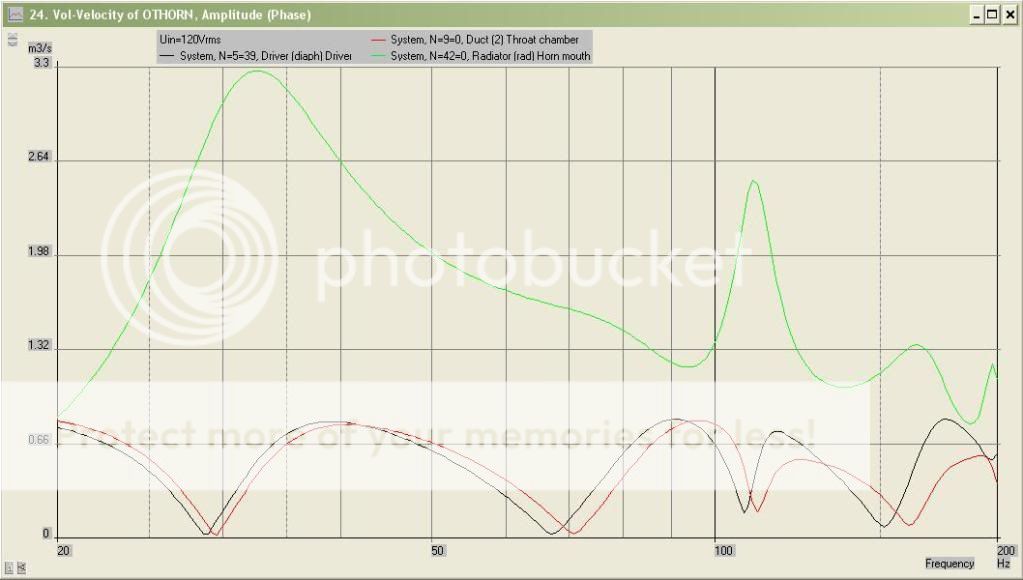
Acceleration

Pressure
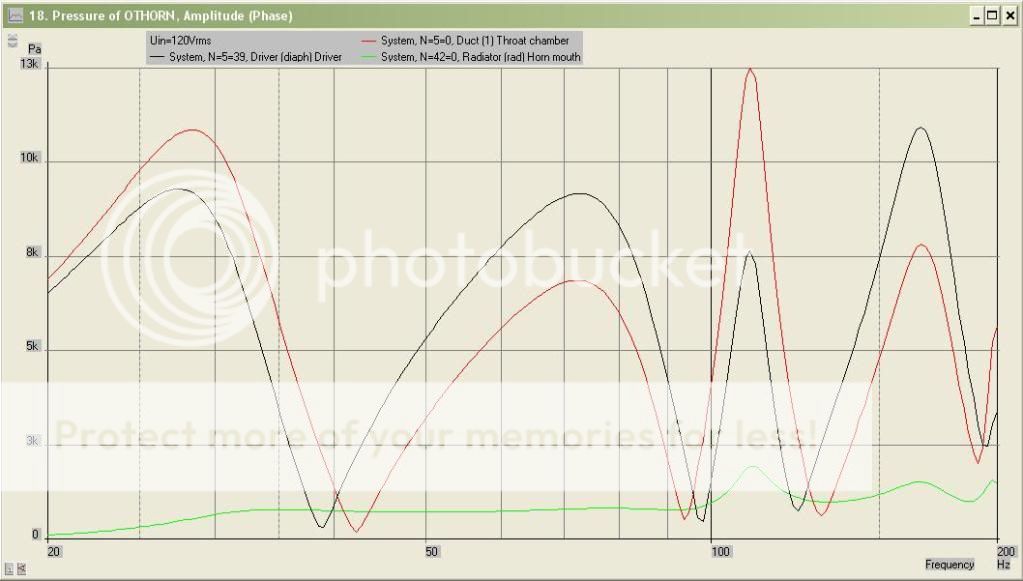
Force
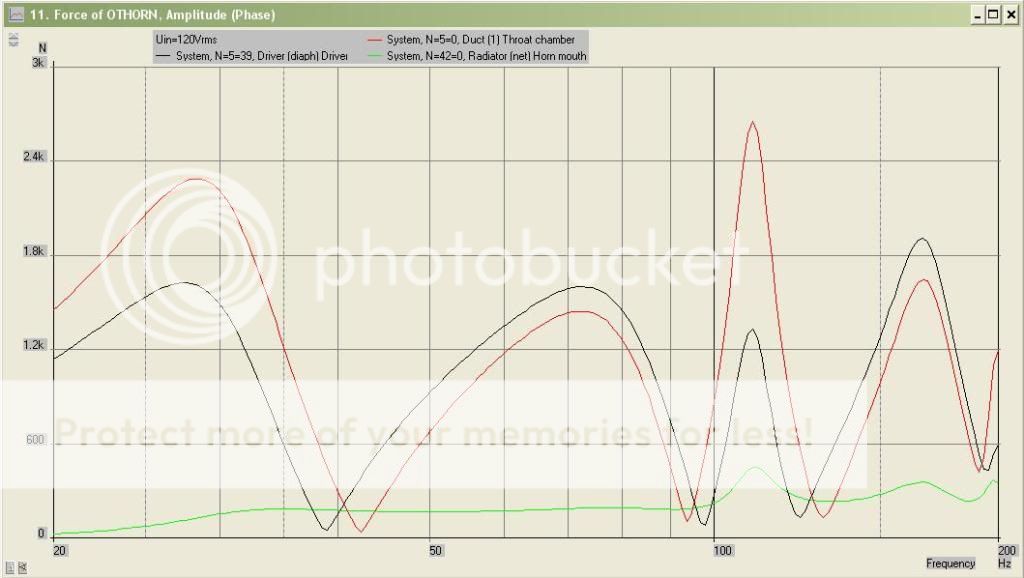
120v input 1m fullspace or 2m halfspace response. The response cuts off where the cone excursion breaks 20mm. Add 6db for 1m half space 120v output

This enclosure should be able to take brief 120v input peaks anywhere above 24hz without risk of damage. Roughly 4200w into the minimum impedances in the pass band. This lines up pretty well with what some of the larger touring amplifiers on the market are rated at into 4ohm stereo loads. At that power level the cone excursion reaches 20mm at the in band excursion peak and at 24.5hz. I know from using these drivers and testing them that this is about the point where they get non linear and start to make suspension noises. Additional input power does not produce much further excursion with these drivers as the motor force is drastically reduced and the suspension is uber tight. An input of about 95volts puts the cone excursion right at xmax between 15-16mm. Also a 25hz 24db octave Butterworth hpf will be used on these since cone excursion sky rockets below 25hz as the driver unloads.
All of the simulation data below is at 120v input.
Akabak power density

HR Excursion 120v

Akabak excursion 120v

Power applied

Current applied

Velocity

Volume Velocity

Acceleration

Pressure

Force

120v input 1m fullspace or 2m halfspace response. The response cuts off where the cone excursion breaks 20mm. Add 6db for 1m half space 120v output

If anyone wants the plans for this cab I have a cnc type Autocad print made up as well as a SLDDRW print and a PDF print of the cabinet plans. It should be enough to build it or adapt it for your own needs if anyone has a need of a cabinet like this. You will have to pm me your email address as the prints are too big to attach here.
Additionally there are other drivers that should also work very well in this cab.
TC Sounds Pro5100
18Sound 21NLW9600
18Sound 18NLW9600
18Sound 18W1000
B&C 18NW100
B&C 18SW115
B&C 21SW150
B&C 21sw152-8 (8 ohm version looks ok, but not as good as the 4 ohm.)
Beyma 18SW1600ND
Faital 18XL1500
Faital 18XL1600 (This one doesn't look as good as the 1500 but it could be a new model.)
Fi Car Audio BTL N2 18d2 ( It does not look as smooth as some of the others and it is a little less sensitive, but excursion would never be an issue with its 30mm xmax and 40mm xmech. Might be worth trying if someone is crazy enough.)
When the subs are complete I will do a full outdoor ground plane test session on them. That will be a few months from now though.
Additionally there are other drivers that should also work very well in this cab.
TC Sounds Pro5100
18Sound 21NLW9600
18Sound 18NLW9600
18Sound 18W1000
B&C 18NW100
B&C 18SW115
B&C 21SW150
B&C 21sw152-8 (8 ohm version looks ok, but not as good as the 4 ohm.)
Beyma 18SW1600ND
Faital 18XL1500
Faital 18XL1600 (This one doesn't look as good as the 1500 but it could be a new model.)
Fi Car Audio BTL N2 18d2 ( It does not look as smooth as some of the others and it is a little less sensitive, but excursion would never be an issue with its 30mm xmax and 40mm xmech. Might be worth trying if someone is crazy enough.)
When the subs are complete I will do a full outdoor ground plane test session on them. That will be a few months from now though.
Work should hopefully start on these in about 3 weeks. As of yet they are just plans and simulation data. They will be built and thoroughly tested though. Last time I waited until the Gjallerhorns were built and already half way through testing before I said anything about them. I figured I'd give a little lead up this time. Who knows maybe someone can get some ideas or have use of the cab design.
Almost forgot here are a couple of more drivers that would work in this cab.
18 Sound 21NLW9000C
18 Sound 18NLW9600C
SSA Zcon 18d2
I will continue looking around for others. Maybe I will stumble on a good lower cost driver that can be used, though most simply do not have enough motor and mass.
18 Sound 21NLW9000C
18 Sound 18NLW9600C
SSA Zcon 18d2
I will continue looking around for others. Maybe I will stumble on a good lower cost driver that can be used, though most simply do not have enough motor and mass.
Maybe I will stumble on a good lower cost driver that can be used, though most simply do not have enough motor and mass.
please try hard for a lower cost driver that *might* work with less then 1000 watts, i dont have 4200 watts ......
but i might find 5 or 700 somewhere cheap one day.....

edit: in fact if you can tell me exactly which ts parameters are the important ones for this box i will also look.
or of course a 15" driver and ill just build it 18" wide instead of 24
Last edited:
Hi Josh, I think you should drop the 18Sound 18W1000 from your list. That driver is (besides old) really not capable handling these wavelength in horns or TH's. It's low Xmax (7mm) is close to its dynamic excursion peak (approx 8,3mm) and the cone is not very strong.
To be honest i just went through my driver data base trying likely suspects and noting those that looked workable. I don't have any familiarity with that driver directly
So what you are saying is that this cone will fold up like a lawn chair at the first sign of real bass with volts behind it.
please try hard for a lower cost driver that *might* work with less then 1000 watts, i dont have 4200 watts ......
but i might find 5 or 700 somewhere cheap one day.....
edit: in fact if you can tell me exactly which ts parameters are the important ones for this box i will also look.
or of course a 15" driver and ill just build it 18" wide instead of 24
You don't need 4kw or even 2kw. All of the ones listed will work perfectly fine on 500w worth of amplifier. You won't find a magic driver that has 3-6db extra sensitivity over the others listed either. This enclosure was designed around a very powerful driver with an extreme amount of motor force, good xmax and a strong cone with a lot of SD. That is the kind of driver that works well in it. Unfortunately most more budget friendly drivers do not possess these attributes.
I cannot tell you what parameters to look for as there are none that will gurantee good performance in this cab. It is the sum of all the parts not any one or 2.
Or it lightens up for a moment to shineSo what you are saying is that this cone will fold up like a lawn chair at the first sign of real bass with volts behind it.Duly noted.

Josh,Here are some images of the cabinet design which was done in SolidWorks.
I see you beefed up the bracing considerably from the Gjallerhorn.
The additional bracing is a good idea, but I would suggest cutting triangular shapes out of the braces, as they may reduce SPL with as much cross sectional area as they have as drawn.
Although I'm sold on the BC18SW115, a pair of Lab 12s worked pretty well in my Keystone TH, and had slightly higher sensitivity than the BC18SW115-4 IIRC.
Would you mind plugging four Lab 12's into the Hornresp sim for the Othorn?
Art
4? I am not sure if they would fit without extensive modification or at all. 3 might be workable. I posted the HR input data. You could give it a whirl yourself you know. 
Yeah I beefed the bracing a lot but I don't think it will affect things much whether it is skeletonized or not. My gut tells me it is negligible.
Yeah I beefed the bracing a lot but I don't think it will affect things much whether it is skeletonized or not. My gut tells me it is negligible.
OTHORN, w/4 Lab 12's
Hi there Josh & Art: For curiousity and as Art requested, I ran HR using Josh's HR input with 4 Lab 12's in a TH 2s x2p with the following results:
16hz, 13 mm-disp
20hz-103.7spl,236w,7.6mm-disp,05.2ohms-imp (rising spl resopnse)
30hz-116.5spl,334w,0.3mm-disp,04.3ohms-imp (rising spl response)
38hz-126.4spl,039w,6.1mm-disp,34.5ohms-imp (spl peak)
60hz-118.8spl,330w,0.8mm-disp,04.4ohms-imp (spl dip)
90hz-126.6spl,040w,2.6mm-disp,34.8ohms-imp (spl peak)
105hz-123.3spl,313w,1.0mm-disp,04.6ohms-imp (spl dip)
115hz-131.0spl,198w, 0.9mmdisp, 7.2ohms-imp (spl peak)
140hz-120.9spl,325w,0.4mm-disp,04.4ohms-imp (spldip)
above 140hz, repeating peaks and dips
conclusion: from 10hz upward, there was no flat response areas...regards, Michael
Josh,...Would you mind plugging four Lab 12's into the Hornresp sim for the Othorn? Art
Hi there Josh & Art: For curiousity and as Art requested, I ran HR using Josh's HR input with 4 Lab 12's in a TH 2s x2p with the following results:
16hz, 13 mm-disp
20hz-103.7spl,236w,7.6mm-disp,05.2ohms-imp (rising spl resopnse)
30hz-116.5spl,334w,0.3mm-disp,04.3ohms-imp (rising spl response)
38hz-126.4spl,039w,6.1mm-disp,34.5ohms-imp (spl peak)
60hz-118.8spl,330w,0.8mm-disp,04.4ohms-imp (spl dip)
90hz-126.6spl,040w,2.6mm-disp,34.8ohms-imp (spl peak)
105hz-123.3spl,313w,1.0mm-disp,04.6ohms-imp (spl dip)
115hz-131.0spl,198w, 0.9mmdisp, 7.2ohms-imp (spl peak)
140hz-120.9spl,325w,0.4mm-disp,04.4ohms-imp (spldip)
above 140hz, repeating peaks and dips
conclusion: from 10hz upward, there was no flat response areas...regards, Michael
Last edited:
Art, the Othorn is designed around a driver with very high BL figures. That means if you want to use Lab 12's you have to enlarge the cab to get similar response.Would you mind plugging four Lab 12's into the Hornresp sim for the Othorn?
- Home
- Loudspeakers
- Subwoofers
- The Othorn tapped horn
